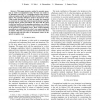Free Online Productivity Tools
i2Speak
i2Symbol
i2OCR
iTex2Img
iWeb2Print
iWeb2Shot
i2Type
iPdf2Split
iPdf2Merge
i2Bopomofo
i2Arabic
i2Style
i2Image
i2PDF
iLatex2Rtf
Sci2ools
ICRA
2009
IEEE
2009
IEEE
Affordance based word-to-meaning association
Abstract-- This paper presents a method to associate meanings to words in manipulation tasks. We base our model on an affordance network, i.e., a mapping between robot actions, robot perceptions and the perceived effects of these actions upon objects. We extend the affordance model to incorporate words. Using verbal descriptions of a task, the model uses temporal co-occurrence to create links between speech utterances and the involved objects, actions and effects. We show that the robot is able form useful word-to-meaning associations, even without considering grammatical structure in the learning process and in the presence of recognition errors. These word-to-meaning associations are embedded in the robot's own understanding of its actions. Thus they can be directly used to instruct the robot to perform tasks and also allow to incorporate context in the speech recognition task.
ICRA 2009 | Model | Robot | Robotics | Word-to-meaning Associations |
| Added | 19 Feb 2011 |
| Updated | 19 Feb 2011 |
| Type | Journal |
| Year | 2009 |
| Where | ICRA |
| Authors | Verica Krunic, Giampiero Salvi, Alexandre Bernardino, Luis Montesano, José Santos-Victor |
Comments (0)

